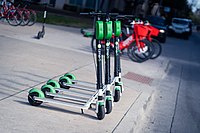Transportation in Texas
This article needs additional citations for verification. (August 2007) |
The Texas Department of Transportation (TxDOT) is a governmental agency and its purpose is to "provide safe, effective, and efficient movement of people and goods" throughout the state.[1] Though the public face of the agency is generally associated with maintenance of the state's immense highway system, the agency is also responsible for aviation in the state and overseeing public transportation systems.
Highways
Texas
One characteristic of Texas's freeways are its
Another common characteristic found near Texas overpasses are the Texas U-turns which is a lane allowing cars traveling on one side of a one-way frontage road to U-turn into the opposite frontage road (typically crossing over or under a freeway or expressway) without being stopped by traffic lights or crossing the highway traffic at-grade.
Most roads, such as rural two-lane roads, rural divided expressways and interstates, and urban interstates are posted at 75 mph (121 km/h), but some rural freeways and interstates have 80 mph (130 km/h) speed limits, and one toll road, Texas State Highway 130, has an 85 mph (137 km/h) speed limit, the highest in the United States.
Traffic safety considerations
Texas and California are comparable being the two largest states in the contiguous United States. This perhaps explains why these two states experience higher traffic fatalities than other states.[2]
There were more traffic fatalities in California than in Texas till 2007. Since 2017, there have been more fatalities in Texas than in California.[2]
The fatality rate by travelled distance and by population is worse in Texas than in the USA.[citation needed]
| Fatalities in Texas | Fatalities in Texas by zone | ||||
|---|---|---|---|---|---|
|
| ||||
| Fatalities in Texas by VMT | Fatalities in Texas by population | ||||
|
| ||||
| Sources: https://cdan.nhtsa.gov/SASStoredProcess/guest
(Eurostat/CARE for comparison to France and Germany) | |||||
Airports

The
Texas's second-largest air facility is Houston's
Some of the other airports that are served by airlines include
Railroads

Part of the state's
Passenger railroads

Passenger rail service in Texas is at this moment[when?] extremely limited from both network viewpoint (with only three routes) and frequency viewpoint (only daily or tri-weekly service), and is certainly to be considered below par for a developed state.
Currently three Amtrak trains serve Texas:
- the daily San Antonio, where through cars are coupled to the Sunset Limited.
- the tri-weekly El Paso.
- the daily Gainesville.
Mass transportation


There are three mass transportation agencies in the
The
VIA Metropolitan Transit (VIA for short) operates bus service in the San Antonio area. VIA is expected to add bus rapid transit service to the area by 2012.
The
The
Ports
Over 1,000
Trans-Texas Corridor
The Trans-Texas Corridor (TTC), officially canceled in 2011,
See also
- Transportation in Dallas, Texas
- Airlines of Texas
- List of Texas railroads
- Plug-in electric vehicles in Texas
References
- ^ "Texas Department of Transportation". Retrieved August 4, 2007.
Providing safe, effective and efficient movement of people and goods.
- ^ a b Walden, Troy D.; Ko, Myunghoon; Wu, Lingtao. "Comparative Analysis of Fatal Crashes in Texas vs. California and Implications for Traffic Safety in Texas" (PDF). Texas A&M Transportation Institute – via Texas Department of Transportation.
- ^ "We Weren't Just Airborne Yesterday". Southwest Airlines. May 2, 2007. Retrieved June 9, 2007.
- ^ International Air Transport Association. "Scheduled Passengers Carried". Archived from the original on April 30, 2007. Retrieved June 10, 2007.
- ^ East Dallas, TX from the Handbook of Texas Online accessed May 7, 2008
- ^ "Texas-Transportation". Advamag, Inc. 2007. Retrieved May 4, 2006.
- Texas Railroad Commission. October 1, 2005. Archived from the originalon November 20, 2007. Retrieved May 4, 2008.
- ^ a b "About Texas Ports". Texas Ports Association. Retrieved May 7, 2008.
- ^ "Benefits of Texas Ports". Texas Ports Association. Retrieved May 7, 2008.
- ^ "General Information". The Port of Houston Authority. March 31, 2008. Archived from the original on May 9, 2008. Retrieved May 7, 2008.
- ^ "Texas Legislature Online - 82(R) History for HB 1201". capitol.texas.gov.
- ^ Crossroads of the Americas: Trans Texas Corridor Plan Report Summary Archived April 11, 2008, at the Wayback Machine
- ^ "Crossroads of the Americas: Trans Texas Corridor Plan". February 27, 2008.


